| Listing 1 - 10 of 53 | << page >> |
Sort by
|
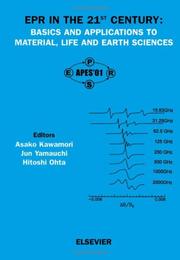
ISBN: 9780444509734 0444509739 9780080539720 0080539726 9786611037499 1281037494 Year: 2002 Publisher: Amsterdam ; Boston : Elsevier,
Abstract | Keywords | Export | Availability | Bookmark
 Loading...
Loading...Choose an application
- Reference Manager
- EndNote
- RefWorks (Direct export to RefWorks)
The Proceedings in this volume are a refereed selection of presentations from The Third Asia-Pacific EPR/ESR Symposium (APES'01), held in Kobe, Japan from October 29 to November 1, 2001. Participants from 20 countries from Asia, Australia, Europe, North and South America presented 210 papers, of which 132 are included here. These Proceedings are also a blueprint for development of electron paramagnetic resonance (EPR) / electron spin resonance (ESR) in the Asia-Pacific region in the 21st century. The Symposium reflected a variety of research fields developed over half a century and f
Book
ISBN: 2759812928 9782759812929 9782759811915 Year: 2014 Publisher: Ulis, France
Abstract | Keywords | Export | Availability | Bookmark
 Loading...
Loading...Choose an application
- Reference Manager
- EndNote
- RefWorks (Direct export to RefWorks)
La spectroscopie de Résonance Paramagnétique Electronique (RPE), c’est-à-dire l’étude de la structure électronique des centres paramagnétiques, est de plus en plus utilisée pour des applications qui vont bien au-delà de celles imaginées initialement par les physiciens. La RPE permet d’obtenir des informations sur l’évolution de propriétés dans le temps (datation) et dans l’espace (traçage). Avec plus d’investissement, elle rend possible l’identification d’une molécule et la détermination de niveaux d’énergie. Cela concerne la physique, la chimie mais aussi les sciences de la Terre et de l’univers, celles de l’environnement, de la vie et de la santé. Cet ouvrage collectif présente une grande variété d’applications. Certaines ne nécessitent pas un bagage théorique important pour être comprises. Pour d’autres, il est possible de se référer à l’ouvrage "La spectroscopie de RPE - Fondements" dans la même collection ou à certains compléments de fin de chapitre. Des annexes sur des méthodes ou techniques sont proposées de façon indépendante en fin d’ouvrage. Enfin, pour chaque application, des références sont proposées à ceux qui veulent approfondir. L’ouvrage est accessible à des étudiants de master 1 de physique, de chimie, de chimie physique, de biophysique et de biochimie. Il sera utile aux professionnels qui utilisent la technique de spectroscopie RPE, aux chercheurs mais aussi aux enseignants du supérieur et des classes préparatoires qui pourront ainsi élargir leurs connaissances de façon très concrète et illustrée. Chaque application est présentée, expliquée par les meilleurs spécialistes de la question, soit une trentaine d’auteurs principaux, coordonnés par Patrick Bertrand qui a repris, avec le soutien de Grenoble Sciences, l’ensemble des productions pour assurer une cohérence et une uniformité de lecture.
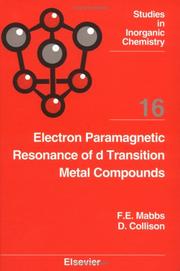
ISBN: 0444898522 1322268851 1483291499 9780444898524 9781483291499 Year: 1992 Publisher: Amsterdam New York Elsevier
Abstract | Keywords | Export | Availability | Bookmark
 Loading...
Loading...Choose an application
- Reference Manager
- EndNote
- RefWorks (Direct export to RefWorks)
Electron paramagnetic resonance (epr) spectroscopy is a sensitive and versatile method of studying paramagnets, which is finding increasing use in chemistry, biochemistry, earth and materials sciences. The technique is treated both qualitatively and quantitatively, with a progressive increase in sophistication in each succeeding chapter. Following a general introductory chapter, the first half of the book deals with single unpaired electron systems and considers both metal and ligand Zeeman, hyperfine and quadrupole interactions. The simulation of these spectra is discussed, followed by the relationship between spin-Hamiltonian parameters and models of the electronic structures of paramagnets. The second half of the book treats multiple unpaired electron systems using the same philosophy. An introduction to the epr properties of cluster compounds and of extended exchanging systems is also given. There is a chapter on linewidths and lineshapes, and an extensive appendix containing much additional information. A wide-ranging library of simulated and experimental spectra is given, as well as graphical data which should aid spectrum interpretation. Each chapter contains key references and there is a substantial subject and keyword index. This book is designed to teach epr spectroscopy to students without any previous knowledge of the technique. However, it will also be extremely useful to researchers dealing with paramagnetic d transition metals.
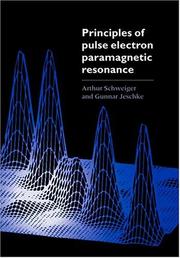
ISBN: 0198506341 Year: 2001 Publisher: Oxford Oxford university press
Abstract | Keywords | Export | Availability | Bookmark
 Loading...
Loading...Choose an application
- Reference Manager
- EndNote
- RefWorks (Direct export to RefWorks)
Pulse EPR (electron paramagnetic resonance) is one of the newest and most widely used techniques for examining the structure, function and dynamics of biological systems and synthetic materials. Until now, however, there has been no single text dedicated to this growing area of research. This text addresses the need for a comprehensive overview of Pulse EPR. The book covers the basic theory of pulse EPR, as well as a description and critical evaluation of the existing and emerging methods needed for selecting and conducting the proper experiment and analyzing the results. This is an indispensable reference for all scientists who need a thorough grounding in this increasingly popular field of spectroscopy.
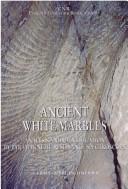
ISBN: 8882652475 9788882652470 Year: 2003 Volume: 122 Publisher: Roma L'Erma di Bretschneider
Abstract | Keywords | Export | Availability | Bookmark
 Loading...
Loading...Choose an application
- Reference Manager
- EndNote
- RefWorks (Direct export to RefWorks)
EPR spectroscopy --- ESR spectroscopy --- Electron paramagnetic resonance spectroscopy --- Electron spin resonance spectroscopy --- Elektronenparamagnetische resonantie spectroscopie --- Marble --- Composition --- -Metamorphic rocks --- Calcium carbonate --- Spectrum analysis --- Electron paramagnetic resonance spectroscopy. --- Composition. --- -Composition --- Metamorphic rocks --- Marble - Composition
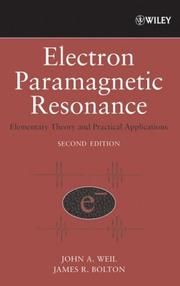
ISBN: 9780471754961 Year: 2007 Publisher: New York (N.Y.) Wiley
Abstract | Keywords | Export | Availability | Bookmark
 Loading...
Loading...Choose an application
- Reference Manager
- EndNote
- RefWorks (Direct export to RefWorks)
544.175 --- Electron paramagnetic resonance spectroscopy --- Electron spin resonance spectroscopy --- EPR spectroscopy --- ESR spectroscopy --- Spectrum analysis --- Electron spin resonance spectra --- Electromagnetism. Ferromagnetism --- Magnetic properties of solids --- Experimental solid state physics --- Theoretical spectroscopy. Spectroscopic techniques --- particle physics --- magnetische velden (fysica) --- deeltjesfysica
Book
ISBN: 3030641988 303064197X Year: 2021 Publisher: Cham, Switzerland : Springer,
Abstract | Keywords | Export | Availability | Bookmark
 Loading...
Loading...Choose an application
- Reference Manager
- EndNote
- RefWorks (Direct export to RefWorks)
Electron paramagnetic resonance spectroscopy. --- Electron spin resonance spectroscopy --- EPR spectroscopy --- ESR spectroscopy --- Spectrum analysis --- Ressonància paramagnètica electrònica --- EPR --- ESR --- Ressonància electrònica --- Ressonància electrònica de spin --- RPE (Magnetisme nuclear) --- Ressonància magnètica --- Interaccions hiperfines --- Espectroscòpia de ressonància paramagnètica electrònica --- Paramagnetisme
Book
ISBN: 0123263506 1322290172 1483191664 Year: 1978 Publisher: New York Academic press
Abstract | Keywords | Export | Availability | Bookmark
 Loading...
Loading...Choose an application
- Reference Manager
- EndNote
- RefWorks (Direct export to RefWorks)
Theoretical spectroscopy. Spectroscopic techniques --- fysicochemie --- 543.422.27 --- Electron paramagnetic resonance spectroscopy --- 539.124 --- Electron spin resonance spectroscopy --- EPR spectroscopy --- ESR spectroscopy --- Spectrum analysis --- Using ultra-high frequency electromagnetic waves (microwaves). Electron spin resonance spectroscopy --- Electrons. Negatrons (including beta-particles). Positrons --- 539.124 Electrons. Negatrons (including beta-particles). Positrons --- 543.422.27 Using ultra-high frequency electromagnetic waves (microwaves). Electron spin resonance spectroscopy
Book
ISBN: 0306401231 1468434438 1468434411 Year: 1979 Publisher: New York Plenum Press
Abstract | Keywords | Export | Availability | Bookmark
 Loading...
Loading...Choose an application
- Reference Manager
- EndNote
- RefWorks (Direct export to RefWorks)
Theoretical spectroscopy. Spectroscopic techniques --- fysicochemie --- 543.422.27 --- Electron paramagnetic resonance spectroscopy --- 539.124-143 --- Electron spin resonance spectroscopy --- EPR spectroscopy --- ESR spectroscopy --- Spectrum analysis --- Using ultra-high frequency electromagnetic waves (microwaves). Electron spin resonance spectroscopy --- Electron paramagnetic resonance spectroscopy. --- 543.422.27 Using ultra-high frequency electromagnetic waves (microwaves). Electron spin resonance spectroscopy --- Crystals --- Esr (electron spin resonance) --- Hemoproteins --- Proteins
Book
ISBN: 3540509445 0387509445 3642746012 3642745997 Year: 1990 Publisher: Berlin Springer
Abstract | Keywords | Export | Availability | Bookmark
 Loading...
Loading...Choose an application
- Reference Manager
- EndNote
- RefWorks (Direct export to RefWorks)
Experimental solid state physics --- Theoretical spectroscopy. Spectroscopic techniques --- fysicochemie --- Electron paramagnetic resonance spectroscopy --- Spectroscopie RPE --- 543.422.25 --- Electron spin resonance spectroscopy --- EPR spectroscopy --- ESR spectroscopy --- Spectrum analysis --- Using high frequency electromagnetic waves (radio waves). Nuclear manetic resonance spectroscopy. NMR spectroscopy --- Electron paramagnetic resonance spectroscopy. --- 543.422.25 Using high frequency electromagnetic waves (radio waves). Nuclear manetic resonance spectroscopy. NMR spectroscopy
| Listing 1 - 10 of 53 | << page >> |
Sort by
|

 Search
Search Feedback
Feedback About UniCat
About UniCat  Help
Help News
News